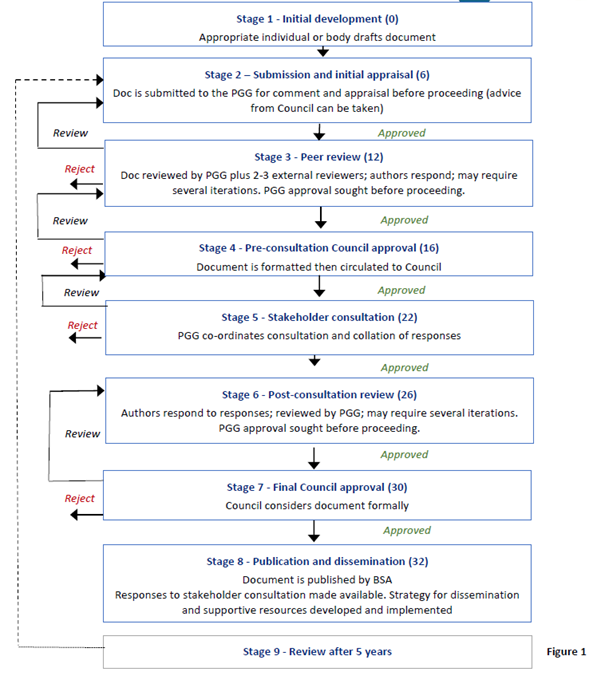Understanding the way in which the BSA manage and process Practice Guidance
One of the activities of the British Society of Audiology (BSA) through the Professional Guidance Group (PGG) is the publication of guidance and other advisory documents on good professional practice in audiology. This is a summary of the processes that these documents go through, including the consultation phase.
Definitions and types of guidance
The type of guidance provided by a document shall be clearly indicated (according to the way in which the BSA formats documents). One document can cover more than one type of guidance.
- Recommended procedure – This provides a standard for the conduct of a specified audiological technique involving a specified group of patients/clients in a specified context.
- Minimum training guidelines – Guidance on training relating to BSA accreditation of training courses
- Practice guidance – This provides broader principles and themes on the topic
- Position statement – This represents a brief synthesis of the current evidence base and consensus on the topic
The process that documents go through to be published as BSA Practice Guidance
To understand the full process please see “Procedure for processing documents for recommended procedures and guidelines” by clicking here.
The principal aims of the policy and procedures in this document are to ensure the consistency and quality of all guidance documents produced and published by the BSA. This is in order to meet the needs of guidance users and to promote the highest standards of professional practice in audiology.
Any individual or group within the BSA is able to submit a document for consideration for publication by the BSA. Exceptionally, a document prepared by an individual or group, who are not members of the BSA, may be considered for publication. However, any documents published in the name of BSA shall be subject to the policy and procedures described here
Figure 1 summarises the process a document must go through to become a published piece of BSA Practice Guidance

The Consultation Process
When a document goes out to stakeholder consultation the PGG are not presuming that the document is in its final format. As part of the consultation we receive comments and recommendations about the content, the evidence, the formatting and language used.
- This consultation covers:
- BSA membership
- International experts
- Lay reviewers may also be invited
- Professional bodies linked to the subject which typically include the British Academy of Audiology, the British Society of Hearing Aid Audiologists, National Community of Hearing Association, the Royal College of General Practitioners & Ear Nose and Throat UK
- We also have (it) the document as open access on both the website and through our social media channels so that the wider hearing and balance community can access this and make comments as part of the consultation
At this stage we welcome comments from all parties, no matter what their experience, seniority or professional background. These responses should be sent to the relevant contact, which is typically the Operations Manager and should use the form specified as part of the consultation by the agreed deadline date. These comments should be limited to this process and should not be communicated through other channels, for example social media streams.
People who are commenting on the draft document should point out any parts of the text they would wish to see changed and ideally suggest alternative wording. The respondent can also direct the authors to other sources of evidence that may not have been referenced. (Ideally, the form used ask anyone responding to suggested replacements to any parts of the text they are not happy with and the respondent can also direct the authors to other sources of evidence that may not have been referenced.)
Please also note that if a revision has taken place on only specified areas of a document and the consultation collates comments on other sections of the document it is up the authors discretion as to whether these are areas of change.
The consultation responses are collated and sent to the author(s) for consideration and action (if required). Members of the BSA are welcome to request a copy of the consultation record for their own interest and review and will be able to view the responses of the authors on each comment.
At this stage all consultation feedback is considered but may not be implemented in the final document that is published. For example, this might be because there is a clear evidence base or a consensus of professional opinion to counter the comment.
Once a document has been updated from all of the feedback it is submitted once more to the Professional Guidance Group and the BSA Council for final reviews before being published. There may be times when the document has altered significantly after a consultation and so a further consultation is deemed appropriate for the newly revised document.
Conflicts of Interest & Transparency
All key authors and the Professional Guidance Group are subject to the BSA’s Conflict of Interest Policy.
All members who are involved in the production of practice guidance complete a conflict of interest form prior to writing the first draft. This is considered alongside the nature and type of guidance document being written by the PGG.
From January 2016 the PGG agreed that for principles of transparency all new or revised documents would have the key author’s names and affiliations stated at the front of the document with any support from key professionals and organisations both nationally and internationally also listed.